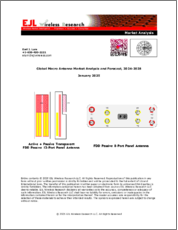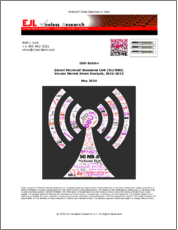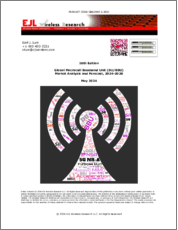
|
시장보고서
상품코드
1796506
매크로셀 베이스밴드 유닛 시장 규모, 점유율, 성장 분석 : 기술별, 컴포넌트별, 배포별, 지역별 - 산업 예측(2025-2032년)Macrocell Baseband Unit Market Size, Share, and Growth Analysis, By Technology (4G LTE, 5G NR), By Component (Hardware, Software), By Deployment, By Region - Industry Forecast 2025-2032 |
||||||
세계의 매크로셀 베이스밴드 유닛 시장 규모는 2023년에 83억 9,000만 달러에 달하며, 2024년에는 96억 7,000만 달러, 2032년에는 158억 6,000만 달러로 성장하며, 예측 기간(2025-2032년)의 CAGR은 7.33%로 성장할 전망입니다.
세계 매크로셀 베이스밴드 유닛 시장은 모바일 데이터 소비의 급증과 네트워크 용량 및 효율성 향상에 대한 요구로 인해 강력한 성장세를 보이고 있습니다. 광범위한 5G 구축에 대한 수요로 인해 서비스 프로바이더는 높은 처리량과 저지연에 대한 요구를 충족시켜야 합니다. 벤더들은 고성능 처리 및 모듈식 업그레이드 기능을 갖춘 고급 베이스밴드 유닛을 통해 이러한 요구를 충족시키고 있으며, 사업자는 하드웨어 교체 없이 용량을 확장할 수 있습니다. 또한 통신 사업자는 트래픽이 많은 상황에서 전력 소비를 관리하는 것을 목표로 하고 있으므로 에너지 효율적인 설계를 추구하는 것이 매우 중요합니다. 주목할 만한 동향은 클라우드 네이티브 아키텍처와 네트워크 기능 가상화 채택으로 확장, 유지보수, 배포가 용이하다는 점입니다. AI를 활용한 오케스트레이션과 엣지 배포와 같은 혁신은 다양한 환경에서 운영 효율성과 사용자 경험을 더욱 향상시킵니다.
목차
서론
- 조사의 목적
- 조사 범위
- 정의
조사 방법
- 정보 조달
- 2차와 1차 데이터 방법
- 시장 규모 예측
- 시장의 전제조건과 제한
개요
- 세계 시장 전망
- 공급과 수요 동향 분석
- 부문별 기회 분석
시장 역학과 전망
- 시장 개요
- 시장 규모
- 시장 역학
- 촉진요인과 기회
- 억제요인과 과제
- Porter의 산업 분석
주요 시장 인사이트
- 주요 성공 요인
- 경쟁의 정도
- 주요 투자 기회
- 시장 에코시스템
- 시장의 매력 지수(2024년)
- PESTEL 분석
- 거시경제 지표
- 밸류체인 분석
- 가격 분석
- 기술 분석
- 사례 연구
- 고객 구매 행동 분석
매크로셀 베이스밴드 유닛 시장 규모 : 기술별 & CAGR(2025-2032)
- 시장 개요
- 4G LTE
- 5G NR
- WCDMA
- CDMA2000
매크로셀 베이스밴드 유닛 시장 규모 : 컴포넌트별 & CAGR(2025-2032)
- 시장 개요
- 하드웨어
- 소프트웨어
- 서비스
매크로셀 베이스밴드 유닛 시장 규모 : 배포별 & CAGR(2025-2032)
- 시장 개요
- 야외
- 실내
- 하이브리드
매크로셀 베이스밴드 유닛 시장 규모 : 지역별 & CAGR(2025-2032)
- 북미
- 미국
- 캐나다
- 유럽
- 독일
- 스페인
- 프랑스
- 영국
- 이탈리아
- 기타 유럽 지역
- 아시아태평양
- 중국
- 인도
- 일본
- 한국
- 기타 아시아태평양
- 라틴아메리카
- 브라질
- 기타 라틴아메리카 지역
- 중동 및 아프리카
- GCC 국가
- 남아프리카공화국
- 기타 중동 및 아프리카
경쟁 정보
- 상위 5사의 비교
- 주요 기업의 시장 포지셔닝(2024년)
- 주요 시장 기업이 채택한 전략
- 최근 시장 동향
- 기업의 시장 점유율 분석(2024년)
- 주요 기업의 기업 개요
- 기업의 상세
- 제품 포트폴리오 분석
- 기업의 부문별 점유율 분석
- 매출의 전년대비 비교(2022-2024년)
주요 기업 개요
- Ericsson(Sweden)
- Nokia(Finland)
- Samsung Electronics(South Korea)
- Fujitsu(Japan)
- NEC Corporation(Japan)
- Cisco Systems(United States)
- Qualcomm(United States)
- Intel Corporation(United States)
- CommScope(United States)
- Mavenir(United States)
- Radisys(United States)
- Parallel Wireless(United States)
- Airspan Networks(United States)
- Casa Systems(United States)
- Ceragon Networks(Israel)
결론과 제안
KSA 25.09.01Global Macrocell Baseband Unit Market size was valued at USD 8.39 Billion in 2023, poised to grow between USD 9.67 Billion in 2024 to USD 15.86 Billion by 2032, growing at a CAGR of 7.33% in the forecast period (2025-2032).
The global macrocell baseband unit market is experiencing robust growth driven by escalating mobile data consumption and the necessity for improved network capacity and efficiency. The demand for extensive 5G deployments puts pressure on service providers to meet high throughput and low latency demands. Vendors are addressing this need with advanced baseband units featuring high-performance processing and modular upgrade capabilities, enabling operators to enhance capacity without hardware replacement. Additionally, the pursuit of energy-efficient designs is crucial as operators aim to manage power consumption under heavy traffic. A notable trend is the adoption of cloud-native architectures and network functions virtualization, allowing easier scaling, maintenance, and deployment. Innovations such as AI-powered orchestration and edge deployment further enhance operational efficiency and user experience across diverse environments.
Top-down and bottom-up approaches were used to estimate and validate the size of the Global Macrocell Baseband Unit market and to estimate the size of various other dependent submarkets. The research methodology used to estimate the market size includes the following details: The key players in the market were identified through secondary research, and their market shares in the respective regions were determined through primary and secondary research. This entire procedure includes the study of the annual and financial reports of the top market players and extensive interviews for key insights from industry leaders such as CEOs, VPs, directors, and marketing executives. All percentage shares split, and breakdowns were determined using secondary sources and verified through Primary sources. All possible parameters that affect the markets covered in this research study have been accounted for, viewed in extensive detail, verified through primary research, and analyzed to get the final quantitative and qualitative data.
Global Macrocell Baseband Unit Market Segments Analysis
The global macrocell baseband unit market is segmented based on technology, component, deployment, and region. In terms of technology, the market is divided into 4G LTE, 5G NR, WCDMA, and CDMA2000. Based on component, the market is trifurcated into hardware, software, and services. Based on deployment, the market is grouped outdoors, indoors, and hybrid. Based on region, the market is segmented into North America, Europe, Asia-Pacific, Latin America and the Middle East and Africa.
Driver of the Global Macrocell Baseband Unit Market
The increasing demand for 5G connectivity significantly propels the global macrocell baseband unit market. Telecommunications operators seek high-performance baseband units designed to manage extensive data volumes while maintaining ultra-low latency. The rise in network traffic, driven by emerging applications such as smart factories and immersive media experiences, compels service providers to invest in scalable baseband solutions. These advanced units offer enhanced throughput, adaptability across various frequency bands, and support for virtualized architectures, making them essential for meeting the dynamic requirements of next-generation network frameworks. Consequently, this investment in robust baseband platforms strengthens their market presence and appeal.
Restraints in the Global Macrocell Baseband Unit Market
The Global Macrocell Baseband Unit market faces notable challenges due to the significant initial capital outlay associated with hardware procurement, installation, and ongoing software licensing. For operators deeply invested in legacy systems, the transition to contemporary baseband solutions can be a daunting task, posing substantial financial burdens. This situation particularly impacts mid-sized carriers and those operating in budget-conscious markets, limiting their capacity to swiftly adopt advanced technologies. Consequently, the reluctance to invest in new infrastructure may hinder operational progress and modernization efforts, curbing the overall growth potential within the sector.
Market Trends of the Global Macrocell Baseband Unit Market
The Global Macrocell Baseband Unit market is witnessing a significant shift towards virtualization and disaggregation, as operators transition from traditional hardware-based baseband units (BBUs) to cloud-native solutions. This trend enables the separation of network functions, allowing for centralized control systems that enhance operational flexibility and scalability. Vendors are developing open-interface architectures that leverage commercial off-the-shelf hardware, promoting simpler deployment and fostering a multi-vendor ecosystem. The adoption of Open Radio Access Network (O-RAN) frameworks is further propelling this evolution, encouraging modular and interoperable components that not only streamline network management but also optimize performance and efficiency across diverse operational environments.
Table of Contents
Introduction
- Objectives of the Study
- Scope of the Report
- Definitions
Research Methodology
- Information Procurement
- Secondary & Primary Data Methods
- Market Size Estimation
- Market Assumptions & Limitations
Executive Summary
- Global Market Outlook
- Supply & Demand Trend Analysis
- Segmental Opportunity Analysis
Market Dynamics & Outlook
- Market Overview
- Market Size
- Market Dynamics
- Drivers & Opportunities
- Restraints & Challenges
- Porters Analysis
- Competitive rivalry
- Threat of substitute
- Bargaining power of buyers
- Threat of new entrants
- Bargaining power of suppliers
Key Market Insights
- Key Success Factors
- Degree of Competition
- Top Investment Pockets
- Market Ecosystem
- Market Attractiveness Index, 2024
- PESTEL Analysis
- Macro-Economic Indicators
- Value Chain Analysis
- Pricing Analysis
- Technology Analysis
- Case Studies
- Customer Buying Behavior Analysis
Global Macrocell Baseband Unit Market Size by Technology & CAGR (2025-2032)
- Market Overview
- 4G LTE
- 5G NR
- WCDMA
- CDMA2000
Global Macrocell Baseband Unit Market Size by Component & CAGR (2025-2032)
- Market Overview
- Hardware
- Software
- Services
Global Macrocell Baseband Unit Market Size by Deployment & CAGR (2025-2032)
- Market Overview
- Outdoor
- Indoor
- Hybrid
Global Macrocell Baseband Unit Market Size & CAGR (2025-2032)
- North America (Technology, Component, Deployment)
- US
- Canada
- Europe (Technology, Component, Deployment)
- Germany
- Spain
- France
- UK
- Italy
- Rest of Europe
- Asia Pacific (Technology, Component, Deployment)
- China
- India
- Japan
- South Korea
- Rest of Asia-Pacific
- Latin America (Technology, Component, Deployment)
- Brazil
- Rest of Latin America
- Middle East & Africa (Technology, Component, Deployment)
- GCC Countries
- South Africa
- Rest of Middle East & Africa
Competitive Intelligence
- Top 5 Player Comparison
- Market Positioning of Key Players, 2024
- Strategies Adopted by Key Market Players
- Recent Developments in the Market
- Company Market Share Analysis, 2024
- Company Profiles of All Key Players
- Company Details
- Product Portfolio Analysis
- Company's Segmental Share Analysis
- Revenue Y-O-Y Comparison (2022-2024)
Key Company Profiles
- Ericsson (Sweden)
- Company Overview
- Business Segment Overview
- Financial Updates
- Key Developments
- Nokia (Finland)
- Company Overview
- Business Segment Overview
- Financial Updates
- Key Developments
- Samsung Electronics (South Korea)
- Company Overview
- Business Segment Overview
- Financial Updates
- Key Developments
- Fujitsu (Japan)
- Company Overview
- Business Segment Overview
- Financial Updates
- Key Developments
- NEC Corporation (Japan)
- Company Overview
- Business Segment Overview
- Financial Updates
- Key Developments
- Cisco Systems (United States)
- Company Overview
- Business Segment Overview
- Financial Updates
- Key Developments
- Qualcomm (United States)
- Company Overview
- Business Segment Overview
- Financial Updates
- Key Developments
- Intel Corporation (United States)
- Company Overview
- Business Segment Overview
- Financial Updates
- Key Developments
- CommScope (United States)
- Company Overview
- Business Segment Overview
- Financial Updates
- Key Developments
- Mavenir (United States)
- Company Overview
- Business Segment Overview
- Financial Updates
- Key Developments
- Radisys (United States)
- Company Overview
- Business Segment Overview
- Financial Updates
- Key Developments
- Parallel Wireless (United States)
- Company Overview
- Business Segment Overview
- Financial Updates
- Key Developments
- Airspan Networks (United States)
- Company Overview
- Business Segment Overview
- Financial Updates
- Key Developments
- Casa Systems (United States)
- Company Overview
- Business Segment Overview
- Financial Updates
- Key Developments
- Ceragon Networks (Israel)
- Company Overview
- Business Segment Overview
- Financial Updates
- Key Developments













